Sacred Heart Catholic Church
Cnr Rathdowne & Pelham Streets, Carlton
Gallery Organ:
William Anderson, 1886
Enlarged c. 1920 (addition of Great Trumpet and bass octave to Swell reeds) Frederick Taylor?
Rebuilt & enlarged 1958 Geo. Fincham & Sons Pty Ltd
3 manuals, 30 speaking stops, 18 couplers, electro-pneumatic action
Sanctuary Organ:
Balbiani, Milano 1929 – for Brigidine Convent, Randwick, NSW; opened 1930
Reb 1965 S.T. Noad & Son, Sydney (new electro-pneumatic action)
Installed 1986 Alan Cargill and others St Francis Xavier's Catholic Church, Bowenfels, NSW
Reb & inst present location 2011-12 Wakeley Pipe Organs Pty Ltd
2 manuals, 7 speaking stops, 10 couplers, electro-pneumatic action
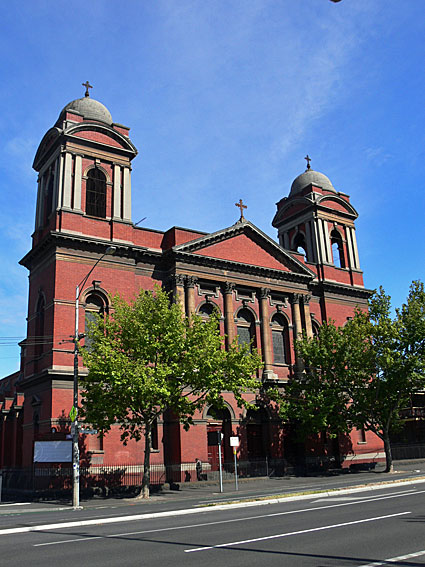
Sacred Heart Catholic Church, Carlton: the principal façade
[photograph by John Maidment (1 February 2012)]
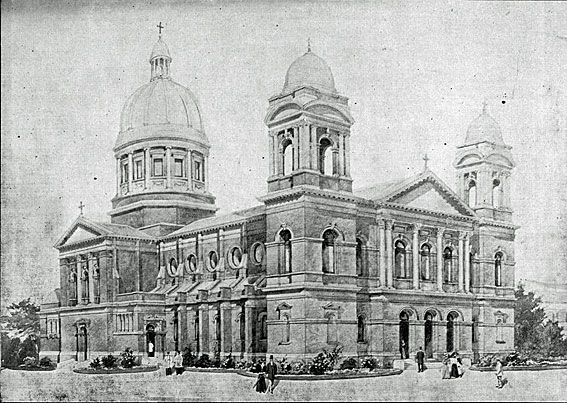
Sacred Heart Catholic Church, Carlton: Reed, Smart & Tappin's intentions for the completed building
[Some of the Fruits of Fifty Years: Ecclesiastical Annals (Melbourne: A.H. Massina, 1897), opp. p.24]
Historical and Technical Documentation by John Maidment
© OHTA, 2012 (last updated May 2012)
The Church of the Sacred Heart replaced an earlier combined church and school, built in bluestone, known as St George's. The new church was opened and blessed by Archbishop Carr on 19 November 1899.1
It was stated that:
The building is unique as far as Victoria is concerned, both as regards its architectural design and the material used in its construction. It is cruciform in plan, and consists of nave, side aisles, and side chapels. It is 170ft in length and 62ft across. The width of the entrance façade to Rathdown-street is 96ft. Frescoe painting and colour decoration make a good internal effect, the interior of the building having been designed with that view. The style of architecture is Renaissance, the building is of brick, and the floor is laid with encaustic tiles. The architects are Messrs Reed, Smart, and Tappin. The total cost of carrying out the plan, which includes a dome of 140ft and two towers 97ft in height, is estimated at £20,000, and the outlay up to the present amounts to about £12,000. The foundation stone was laid by Archbishop Carr on the 20th June, 1897.2
More detail was given in the book Some of the Fruits of Fifty Years: Ecclesiastical Annals:
The plan is cruciform, and consists of nave with side aisles, transepts, sanctuary, side chapels, sacristies, etc. A choir gallery and organ chambers will be at the eastern end, approached by a stone staircase in one of the towers. The plan is modern in its arrangement of side aisles, which are divided from the nave by heavy arcading, and are intended to afford ample space for processions and access to the seats, which are placed in the loftier portion of the building, where an uninterrupted view of the sanctuary can be obtained by the congregation. A narthex, or entrance lobby, extending over the whole front of the building, forms a splendid entrance, and gives free access to the various parts of the church. The baptistery is situated under one of the towers and opens off the narthex. The main ceilings are elliptical in form, with moulded ribs springing from wall pilasters. The clerestory is lit by large circular windows.
The total length of the church is 176 feet; width across nave and aisles 62 feet; width of nave 37 feet 9 inches; of transepts 33 feet 9 inches; diameter of dome 40 feet. The height of nave and transepts is 51 feet; of dome to top of cross 140 feet; and of each of the flanking towers, 97 feet. The width of the entrance façade to Rathdowne Street is 96 feet.3
It had been intended to commission a new organ for Sacred Heart Church and Fincham & Hobday quoted to the Revd J.H. Connell on 30 July 1897 to build the following instrument:
Great Organ
Double Open Diapason
Open Diapason
Horn Diapason
Clarabella
Dulciana
Quint
Principal
Harmonic Flute
Twelfth
Fifteenth
Posaune
Clarion
Swell Organ
Bourdon
Geigen Principal
Gedact
Salicional
Vox Angelica
Gemshorn
Rohr Flote
Harmonic Gemshorn
Mixture
Contra Fagotto
Cornopean
Oboe
Oboe Clarion
Tremulant
Choir Organ
Harmonic Flute
Gedact
Gamba
Celeste
Clear Flute
Piccolo
Clarionet
Orchestral Oboe
Vox Humana
Tremulant
Pedal Organ
Open Diapason
Bourdon
Principal
Violon
Gemshorn
Trombone
Couplers
Swell to Great
Swell to Choir
Swell to Pedal
Great to Pedal
Choir to Pedal
|
16
8
8
8
8
6
4
4
3
2
8
4
16
8
8
8
8
4
4
2
3 rks
16
8
8
4
8
8
8
8
4
2
8
8
8
16
16
8
8
4
16
|
gvd. bass
gvd. bass
TC
TC
wood
|
|
Crescendo pedal to Swell Organ
Crescendo pedal to Choir Organ
3 composition pedals to Great Organ
3 composition pedals to Swell Organ
Price erected in the church £1607 allowing the church £286 for the old organ.
The tubular pneumatic action be preferred
The following additions will be made
Couplers
Swell Super Octave
Swell Sub Octave
Great Super Octave
Great Sub Octave
Also four buttons to Swell Organ, five to Great Organ, three to Choir Organ
Leaving out the composition pedals above mentioned
Price erected in the church £1,8004
Sadly, funds were short at the time and this instrument was never commissioned. It was not possible to complete the building and a flat-roofed temporary sanctuary, that remains today, was placed in the crossing space using the original painted wooden high altar, designed by J.B. Denny, from St Patrick's Cathedral. A new organ was clearly beyond the parish's financial means, so the organ built for the previous St George's Church was moved into Sacred Heart Church and centrally placed on the rear gallery. The façade pipes of this instrument, which were originally intricately decorated, survive inside the present organ.5
There is no record of the full specification of this organ, but it may be deduced as follows from an examination of the surviving pipework, windchests, and a report made in 1917 by J.E. Dodd6:
GREAT
Double Diapason
Open Diapason
Stop Diapason Bass
Clarabella
Dulciana
Principal
Flute
Twelfth
Fifteenth
Swell to Great
SWELL
Open Diapason
Stop Diapason
Keraulophon
Gemshorn
Piccolo
Cornopean
Hautboy
PEDAL
Open Diapason
Bourdon
Great to Pedal
Swell to Pedal
|
16
8
8
8
8
4
4
2-2/3
2
8
8
8
4
2
8
8
16
16
|
CC-BB
TC
TC
gvd.bass
TC
TC
wood
wood
|
|
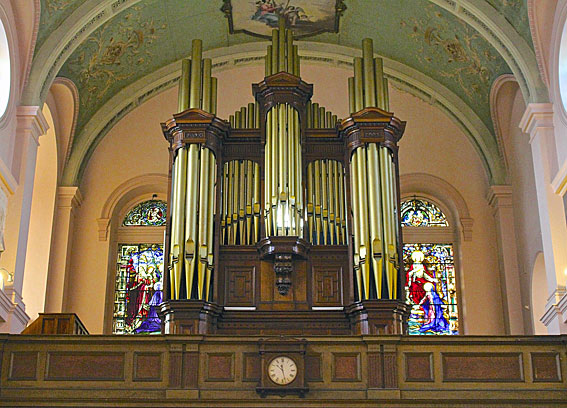
Sacred Heart Catholic Church, Carlton: casework of the gallery organ
[photograph by Trevor Bunning (September 2017
)]
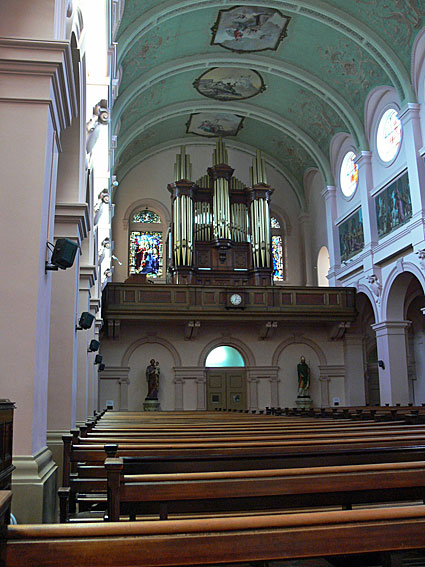
Sacred Heart Catholic Church, Carlton: casework of the gallery organ
[photograph by John Maidment (1 February 2012)]
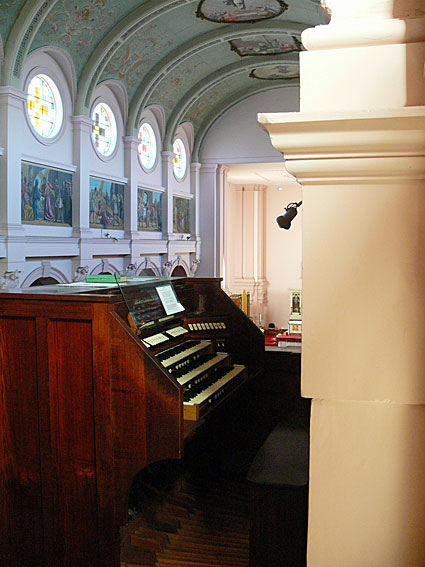
Sacred Heart Catholic Church, Carlton: console of the gallery organ
[photograph by John Maidment (1 February 2012)]
The gallery organ at Sacred Heart Church includes pipework, two slider windchests and side panels from an organ installed in 1886 in the former St George's Church, Carlton by Melbourne organbuilder William Anderson. A Trumpet was later added, either by J.E. Dodd, who quoted to do so in 1917, together with new basses to the swell reeds6, or more likely by Frederick Taylor.7
The Anderson organ was extensively rebuilt in 1958 by Geo. Fincham & Sons Pty Ltd. At this time a magnificent earlier organ case in blackwood was used to clothe the instrument, made for the 1890 Fincham & Hobday organ in the Australian Church, Melbourne by cabinet maker George Nelson Bell at a cost of £220 and designed by architect William Salway (the remainder of the Australian Church organ went to Wilson Hall, University of Melbourne).
A new three-manual stopkey console with electro-pneumatic action were provided, and a second-hand slider chest for the Choir Organ came from the 1922 organ built by the Fincham firm for St Mary's Mission, Fitzroy Street, Fitzroy, which had been broken up in 1956; some of the Choir pipework came from this source. The 16ft façade pipes, with nicely shaped ogee mouths, are from the Australian Church. This instrument sounds extremely well in a highly resonant acoustic.8
The Great Mixture has been accommodated on the slide originally occupied by the Anderson Fifteenth, which was moved to the Twelfth slide, as per J.E. Dodd's recommendations. The hooded Trumpet was placed on this slide but was relocated on to a unit chest in 1958. This stop is of small scale, so it could be accommodated on the Anderson Great slider chest. There is also one slide free on this eight-rank chest, which may have been occupied by a 16ft, referred to in The Advocate account. On the Swell, the two reeds have new zinc basses, again as recommended by Dodd, as the originals were only complete to Tenor C. The so-called Violone 16ft is a transposed Gamba and occupies the slide probably used by Anderson for one of his signature Keraulophon stops. On the Choir, the wooden Gedact, zinc and spotted metal Gamba and wooden open Flute 4 appear to be 1920s Fincham pipework, probably from St Mary's Mission, Fitzroy.
GREAT
Double Open Diapason
Open Diapason
Claribel
Dulciana
Principal
Flute
Fifteenth
Mixture
Trumpet
Great Sub Octave
Great Unison Off
Great Super Octave
Swell to Great Sub
Swell to Great
Swell to Great Super
SWELL
Violone
Open Diapason
Stopped Diapason
Gemshorn
Piccolo
Cornopean
Oboe
Tremulant
Swell Sub Octave
Swell Super Octave
CHOIR (unenclosed)
Gedact
Gamba
Flute
Nazard
Piccolo
Tierce
Tremulant
Choir Sub Octave
Choir Super Octave
Swell to Choir
PEDAL
Resultant Bass
Open Diapason Wood
Open Diapason Metal
Bourdon
Principal
Bass Flute
Fifteenth
Trumpet
Great to Pedal
Swell to Pedal
Choir to Pedal
Pedal Super Octave
|
16
8
8
8
4
4
2
V
8
16
8
8
4
2
8
8
8
8
4
2-2/3
2
1-3/5
32
16
16
16
8
8
4
8
|
A
B
C
C
A
D
A
D
A
B
|
new bass provided CC-BB
on Anderson Twelfth slide
[actually III-V] on Anderson Fifteenth slide 1958
Taylor c.1920 harmonic trebles
TC on Anderson Keraulophon slide? 1958
tapered
wood and metal
later zinc basses CC-BB Taylor c.1920
later zinc basses CC-BB Taylor c.1920
1920s
1920s
1920s
|
Compass: 61/32
There is an extensive range of adjustable thumb and toe pistons and a general crescendo pedal9
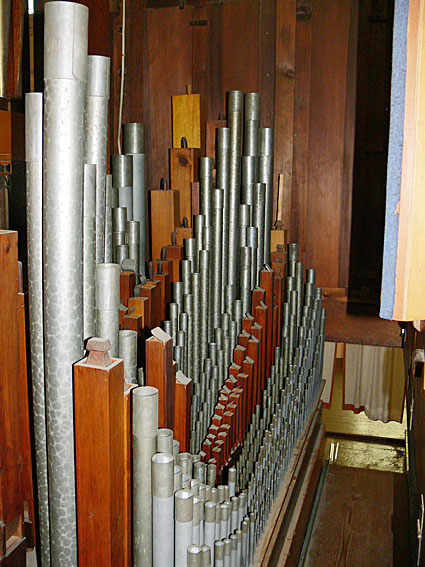
Sacred Heart Catholic Church, Carlton: Great Organ pipework of the gallery organ
[photograph by John Maidment (1 February 2012)]
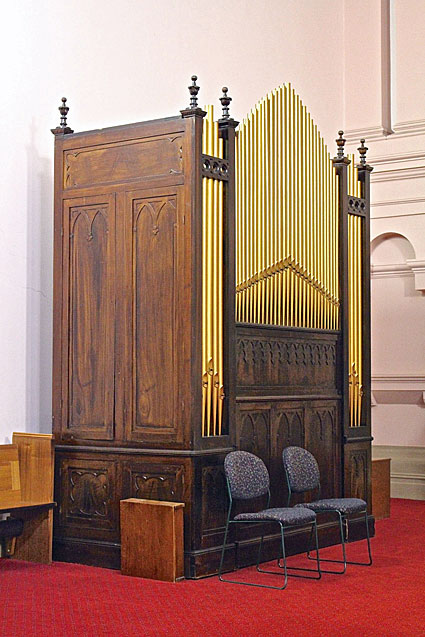
Sacred Heart Catholic Church, Carlton: sanctuary organ
[photograph by Trevor Bunning (September 2017)]

Sacred Heart Catholic Church, Carlton: sanctuary organ
[photograph by John Maidment (1 February 2012)]
The sanctuary organ was built in 1929 by the Italian firm of Balbiani, based in Milan, for the Brigidine Convent, Randwick, NSW.10 It was commissioned through Don Mario Pettorelli, who was Director of Music for the 1928 Eucharistic Congress in Sydney and in 1930 was appointed Director of Music at St Mary's Cathedral, Sydney.11 The instrument was opened at Randwick on 27 April 1930; it appears that Pettorelli was responsible for its installation.12
In 1965, the Sydney firm of S.T. Noad & Son electrified the action and inserted plastic stopkeys in place of the original Balbiani red and green off and on switches for the stops and couplers.13
In 1986 the instrument was moved to St Francis Xavier's Catholic Church, Bowenfels, NSW, on the outskirts of Lithgow. This work was carried out by Alan Cargill and others.
With the closure of the Bowenfels church, the instrument became redundant and was purchased by the Corpus Christi Seminary of the Catholic Archdiocese of Melbourne for installation in Sacred Heart Catholic Church, Carlton as a sanctuary organ, for the accompaniment of seminarians, for which the gallery organ is too remote.
The work of renovation has been carried out by Wakeley Pipe Organs Pty Ltd. The sliderless 73-note windchests have been thoroughly overhauled, the wind system restored, and the pipework repaired, all of which survives from 1929, without alteration to voicing. The console has been detached from the organ and placed in the second bay of the nave, facing across the building. The woodwork has been extended to form sides and back, and a new music desk, in Balbiani style, constructed. Small wooden turned drawstops replaced the Noad stopkeys and new porcelain labels manufactured by Laukhuff in Germany have been placed above the knobs, their lettering exactly matching the original porcelain labels on the composition pedals. A new solid-state switching and combination action has been installed. The casework has had a new matching panel made for the front, where the console was located, and the whole repolished, with the dummy façade pipes refinished in gold lacquer.
The whole organ is enclosed in a swell box, with the shutters mounted on the roof. The pipework retains its original tuning scrolls and canisters, the string ranks being fitted with freins harmonique in front of the mouths, while several of the ranks have unusual nicking patterns on the languid, a deeper nick being interspersed with more frequent lighter nicks. The voicing is highly distinctive, combining overall clarity and precision of speech with an attractive colour, unique in the local environment. This is the only Italian romantic style organ in the country, although three later instruments by the firms of Pinchi and Ruffatti may be found in NSW churches. The couplers are an integral part of the tonal design, with the manual windchests extending to 73 notes.
MANUALE Io
Principale
Bordone
Dolce
Man I Sub
Man I Oct
Man II – Man I Sub
Man II – Man I
Man II – Man I Oct
MANUALE IIo
Gamba
Voce Celeste II
Flauto
Man II Sub
Man II Oct
PEDALE
Bordone
Man I – Ped
Man II – Ped
Man II – Ped Oct
|
o
8
8
8
o
8
8
4
16
|
canistered metal
harmonic
|
|
Tremolo
Compass: 61/30
Electro-pneumatic action
Detached drawstop console
Four thumb pistons to Manual I: Cancel, PP, MF, FF
Four thumb pistons to Manual II: Full organ, PP, MF, FF
General crescendo pedal with indicator dial: 'Graduatore'
Balanced swell pedal: 'Expressione Io e IIo Manuale'
Composition pedal: 'Copula Generale'
Composition pedal: 'Combinazione libra'
Composition pedal: 'Tutti'14
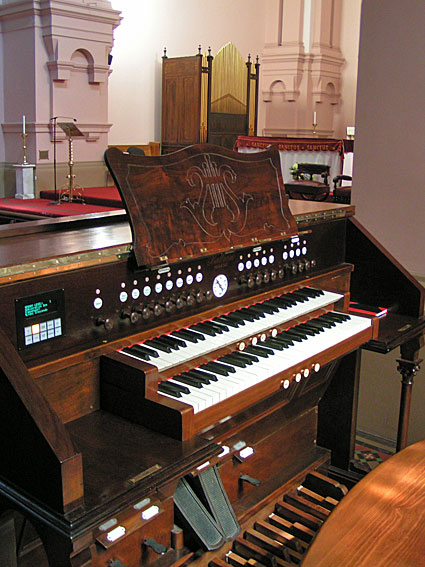
Sacred Heart Catholic Church, Carlton: console of the sanctuary organ
[photograph by Ian Wakeley (20 March 2012)]

Sacred Heart Catholic Church, Carlton: console detail of the sanctuary organ
[photograph by Trevor Bunning (September 2017)]
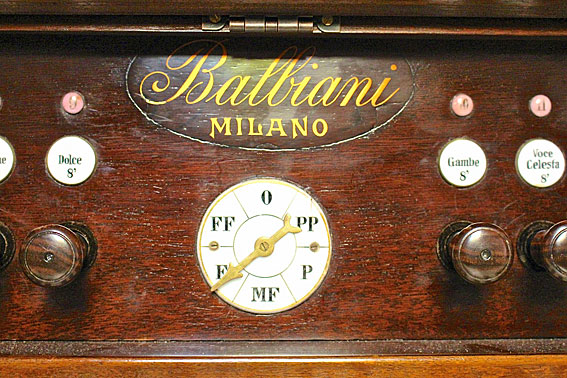
Sacred Heart Catholic Church, Carlton: console detail of the sanctuary organ
[photograph by Trevor Bunning (September 2017)]
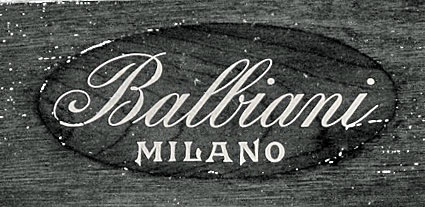
Sacred Heart Catholic Church, Carlton: nameplate of the sanctuary organ
[photograph by Geoffrey Cox (24 January 2012)]
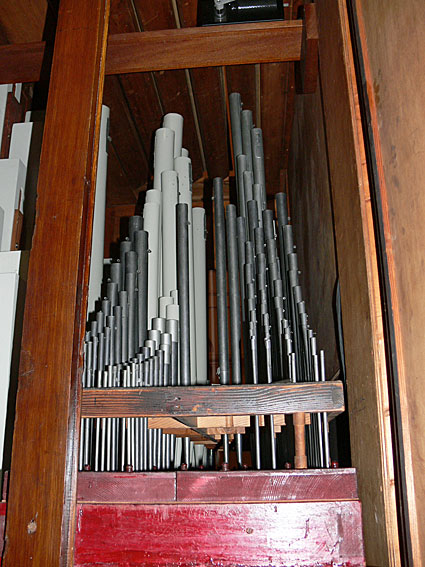
Sacred Heart Catholic Church, Carlton: pipework of the sanctuary organ
[photograph by John Maidment (27 February 2012)]
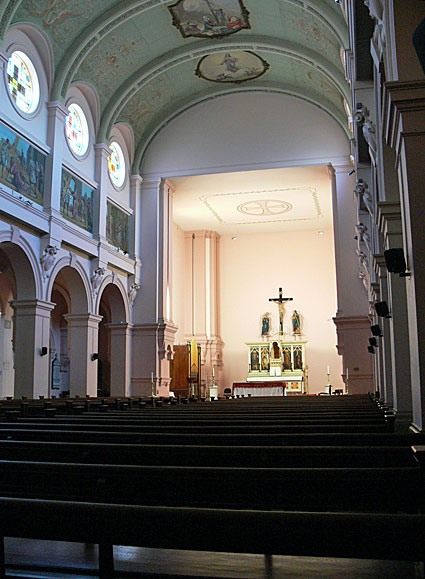
Sacred Heart Catholic Church, Carlton: view of the interior with the sanctuary organ to the left
[photograph John Maidment (2 February 2012)]
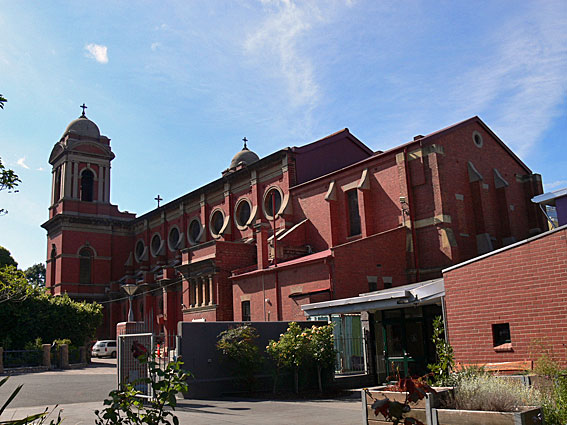
Sacred Heart Catholic Church, Carlton: the exterior viewed from the Seminary
[photograph by John Maidment (2 February 2012)]
1 The Argus 20 November 1899, p.6
2 Ibid
3 Some of the Fruits of Fifty Years : Ecclesiastical Annals (Melbourne: A.H. Massina, 1897), p. p.24
4. George Fincham letter books, p.256, July 30th 1897 (held by the State Library of Victoria)
5 Internal inspection by John Maidment 1990s
6 Dodd letter books, pp.633-636, letter to Fr O'Connell, 22 August 1917 (courtesy of David Shield)
7 Christopher E. Wells (a former employee of Frederick Taylor) to John Maidment [1980s?]
8 Notes made by John Maidment 1966
9 Specification noted by John Maidment 1966 (this remains unchanged)
10 Information supplied by Marco Brandazza 14 December 2011 from
a list of organs in an article by Silvana Simonetti "Bossi-Vegezzi-Balbiani, costruttori di organi", Istituto della Enciclopedia Italiana (Roma 1967) p.16
11 Sydney Morning Herald, 13 February 1930, p.6
12 Dr Geoffrey Cox, 'Successful Balbiani Transplant from Bowenfels, NSW to Carlton, Victoria', OHTA News, vol 36 no 2 (April 2012), p.15
13 Information from Robert Wallace 1969 to John Maidment; illustrations of Balbiani organs with this feature may be found on Google Images
14 Technical details and specification noted by John Maidment 2011, 2012














